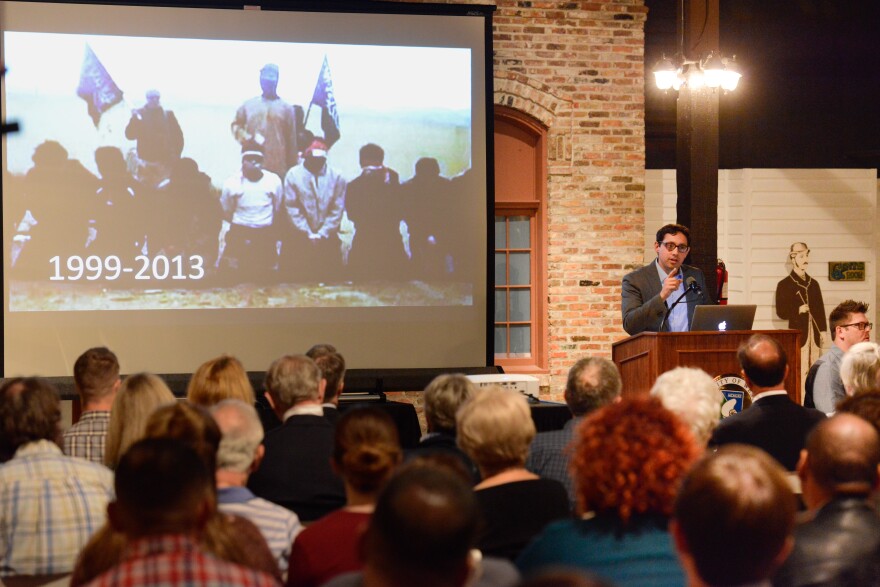In just three years, ISIS has gone from an unknown entity to an international security threat, and while many know the group’s deeds, less know who they are and where they came from.
Hundreds gathered on Thursday evening at the Museum of Commerce in downtown Pensacola to hear the University of West Florida’s Dr. Jacob Shivley, a researcher who focuses on US foreign policy and national security strategies and Dr. Michelle Williams, an expert in far-right and extremist parties, spoke about the terrorist group’s identity, ideology and sustainability.
The talk entitled, ““Radicalism, ISIS, and National Security,” part of the Experience UWF Dowtown Lecture series began with Shivley addressing the roots of ISIS, which date back to 1999.
“The extremists in the Fertile Crescent at that time were already beginning to mobilize, but it was the attacks of 9/11 that really catalyzed this movement,” Shivley said. “That’s when the clear enemy became the West.”
Previous terrorist groups had focused on local regimes, but following the invasion of Iraq in 2003, Al-Qaeda in Iraq emerged, under the leadership of Abu Musab al-Zarqawi.
“He (al-Zarqawi) saw the group’s enemies not only as America, but also other sects in the Islamic religion who didn’t share a strict interpretation of the faith,” Shivley said.
In 2006, al-Zarqawi was killed, but the core of the movement persisted. By 2007, the U.S. realized that action was needed to crush the movement and President George W. Bush ordered the “surge” of U.S. troops into the country.
“It worked,” Shivley said. “Insurgents were captured and Al-Qaeda in Iraq flamed out. But while imprisoned, these men licked their wounds, were released and began to recover the movement.”
The radical movement had deep roots and a strong foundation when the U.S. withdrew from Iraq in 2011 and a new insurgency began to rise.
“There was no more stabilizing force there,” Shivley said. “This instability allowed the movement to grow.”
The civil war in neighboring Syria also helped foster the terrorist organization.
“By 2014, there was nothing to stop them,” he said. “They began to find a political space in which they could expand.”
In the region, ISIS began to become known for their brutality, which they used to convey their intentions and recruit supporters for their ultimate goal of establishing their own state. The U.S. view of the group was still that they were the “JV team” of terrorist organizations, according to Shivley.
“There was suddenly a realization that ISIS posed an actual threat and the U.S. sent troops and advisors into the region,” he said.
By August 2014, ISIS began what amounted to genocide against those who didn’t follow their ideals.
“Minority groups were attacked and killed,” Shivley said. “Others began to flee.”
Shortly after, ISIS made its first direct challenge to the U.S. when they captured and beheaded American James Foley and the U.S. responded.
“Airstrikes against ISIS began shortly after that and began to weaken the insurgency,” Shively said. “At this point, ISIS began to shrink.”
ISIS’s success in creating their insurgency came from several different things: regional instability, pre-existing networks, the tension between the Sunni and Shia and a social media presence that created an international appeal, according to Shivley.
“They understood that if people don’t trust the system, that violence becomes appealing,” he said.
The basis for creating that movement was discussed by Williams, who said that ISIS did what many extremist groups do: focus on the disenfranchised.
“Extremists don’t play by the institutional rules; they go into self-imposed isolation,” she said. “They are seeking revolutionary change and use violence when other methods don’t work. They represent the minority and seek a void to fill in the ideological space.”
Williams also said that radicals often tend towards authoritarian rule.
“Radical principles are not compatible with democracy,” she said. “There is a difference of degree, not kind.”
In the case of ISIS, that’s a strict interpretation of Islam, with an apocalyptic end as its goal.
“These are religious radicals,” Williams said. “They are made up of religious leaders – virtuosi, spiritual exemplars, charismatic figures; intellectuals – theologians, judges, scholars, educators; and religious officials – clerics and bishops.”
These leaders espouse this end times ideology that becomes very appealing for frustrated youth looking for revolutionary change. This is not an easy battle to fight for the West, according to Shivley.
“We can’t change radicalism and these aren’t central organizations or nation states like we used to see in earlier terrorist groups,” he said.
The current U.S. response has been to help the regions effected regain their own control through humanitarian and military aid, air strikes, the use of Special Forces and protecting homeland security. But there are also constraints that hold the U.S. back from full military action.
“Most people in this country don’t want to see us involved in another war in the Middle East,” Shivley said. “We also have to consider our regional allies and the complex geopolitics of the region.”
This article is part of a collaboration between WUWF and the UWF Center for Research and Economic Opportunity.





